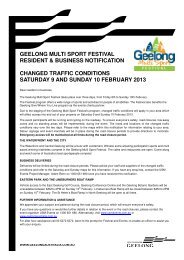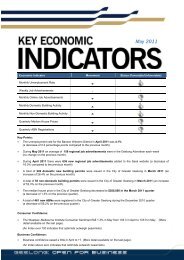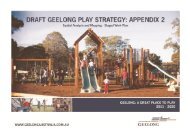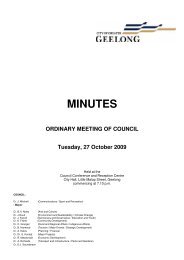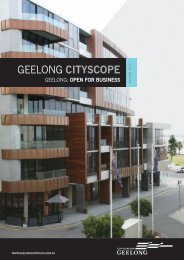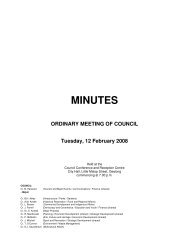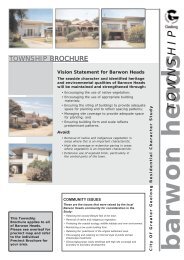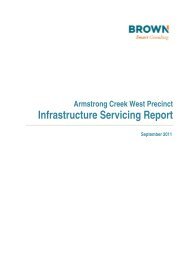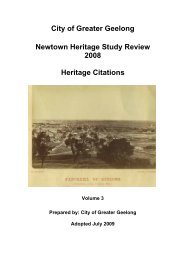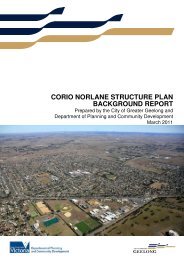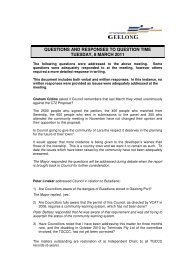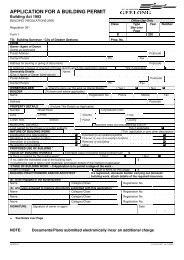ANNUAL REPORT 2007-2008 CITY OF GREATER GEELONG
ANNUAL REPORT 2007-2008 CITY OF GREATER GEELONG
ANNUAL REPORT 2007-2008 CITY OF GREATER GEELONG
You also want an ePaper? Increase the reach of your titles
YUMPU automatically turns print PDFs into web optimized ePapers that Google loves.
OUR HISTORY - FROM JILLONG TO <strong>GEELONG</strong><br />
Geelong has a long and proud history dating<br />
back well before white settlement.<br />
The Wathaurong people lived in the Geelong region for<br />
more than 25,000 years before white settlers arrived with<br />
various clans established in the area. White settlement<br />
from the early 1800s had a devastating effect on the<br />
Aboriginal people. Sheep destroyed much of the root<br />
crops which the Wathaurong depended on, and<br />
introduced diseases that cut a swathe through their<br />
people causing birth rates and clan numbers to fall.<br />
The significant level of activity of the Wathaurong people<br />
is evident through approximately 140 archaeological sites<br />
that have been found in the region.<br />
The name Geelong itself comes from the term Jillong.<br />
When the explorers Hume and Hovell arrived in the area<br />
in 1824, they approached the Wathaurong people and<br />
asked for the name of the area. They were informed that<br />
the bay was called Jillong and the land Corio, or at least<br />
this is how they construed the conversation.<br />
The actual meaning of these two words has been subject<br />
of much speculation over the years. There is a belief that<br />
the Europeans had made a mistake in ascribing Corio to<br />
the sea and Geelong to the land, when it should have<br />
been the other way around. The debate goes on!<br />
Following is a short chronological history of Geelong,<br />
from the early 1800s through to today.<br />
1802 - Lieut. John Murray from the Lady Nelson<br />
discovered and explored Corio Bay.<br />
1802 - Commander Matthew Flinders entered Port Phillip<br />
Bay onboard the Investigator and climbed Station<br />
Peak (now known as Flinders Peak at the<br />
You Yangs).<br />
1824 - Explorers Hume and Hovell reached the shore<br />
of Corio Bay (close to the present Duck<br />
Ponds Bridge).<br />
1837 - Capt Foster Fyans arrived at Geelong as Police<br />
Magistrate.<br />
1837 - David Fisher built the first house in Geelong.<br />
1838 - Geelong surveyed.<br />
1838 - Geelong gazetted as a town.<br />
1838 - First land sale held.<br />
1840 - First issue of the “Geelong Advertiser” published.<br />
1849 - Town of Geelong incorporated by special Act of<br />
the New South Wales Legislative Council.<br />
1850 - First meeting of Geelong Town Council held.<br />
1853 - Geelong-Melbourne Railway commenced.<br />
1857 - Post Office built at corner of Ryrie and<br />
Gheringhap Streets.<br />
1858 - Geelong Gas Company incorporated.<br />
1859 - Geelong Yacht Club formed.<br />
1861 - Geelong College founded.<br />
1862 - Geelong- Ballarat railway opened.<br />
1872 - Johnstone Park opened.<br />
1872 - National Wool Museum built.<br />
1877 - Geelong Railway Station building commenced.<br />
1887 - Gordon Institute of Technology opened.<br />
1890 - Cheetham Salt Works established.<br />
1899 - Geelong Electric Syndicate granted consent to<br />
install electric lights and power.<br />
1905 - Harbour Trust for the Geelong Port passed<br />
by Parliament.<br />
1905 - New Racecourse and Agricultural Show<br />
Grounds gazetted.<br />
1908 - Geelong Waterworks and Sewerage Trust formed.<br />
1908 - Geelong’s first car constructed by Humble<br />
and Sons.<br />
1910 - Ratepayer approval secured to develop Market<br />
Square for retailing purposes.<br />
1910 - Geelong declared a city.<br />
1912 - Geelong Electric Tramway Service opened.<br />
1912 - First automatic telephone exchange in<br />
Australia opened at Geelong.<br />
1914 - Geelong Grammar School opened in Corio.<br />
1915 - Geelong High School officially opened.<br />
1915 - Woollen Mills at North Geelong opened.<br />
1917 - New City Hall, Geelong, officially opened.<br />
1924 - Wards at Kitchener Memorial Hospital officially<br />
opened.<br />
1925 - Geelong Football Club won its first VFL Premiership.<br />
1925 - Ford Motor Company commenced operations.<br />
1926 - The ‘Palais’ opened in Moorabool Street.<br />
1926 - Concrete Barwon Bridge officially opened.<br />
1927 - Eastern Beach improvements commenced.<br />
4



